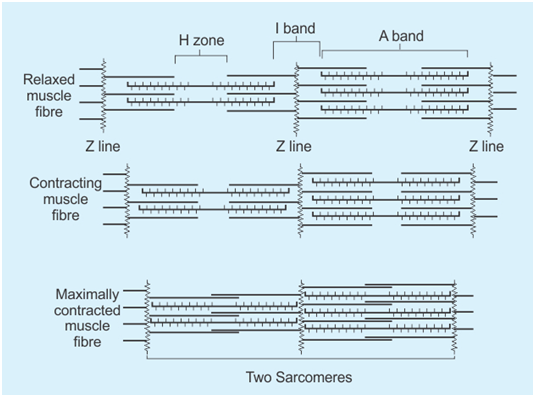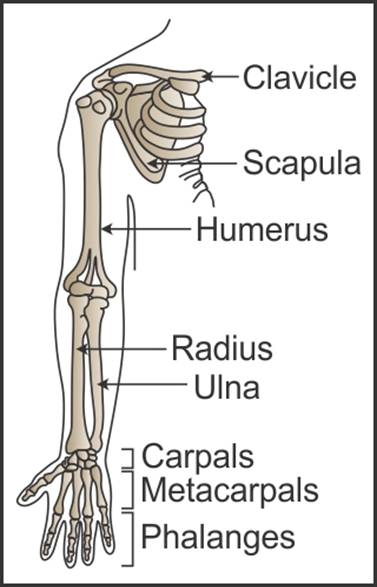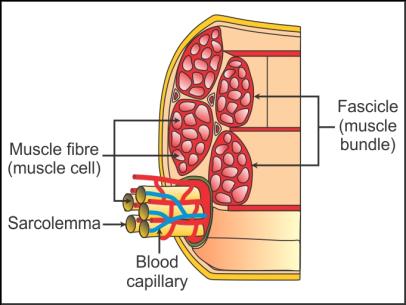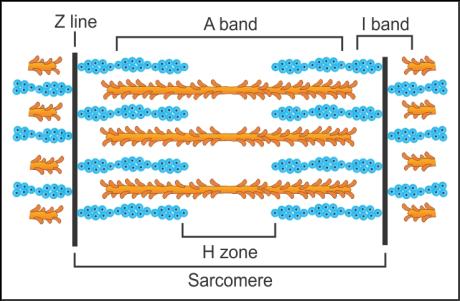Q1. Name the monomer of myosin filament.
Solution
Meromyosin
Q2. Represent diagrammatically the sliding filament theory.
Solution
Sliding filament theory:


Q3. Name the hormone responsible for osteoporosis.
Solution
Oestrogen
Q4. Why are skeletal muscles called striated muscles?
Solution
The skeletal muscles have a stripe-like appearance when observed under
the microscope. Hence, they are called striated muscles.
Q5. Name the bone present at the base of the buccal cavity.
Solution
Hyoid bone is present at the base of the buccal cavity.
Q6. How many bones are present in the front part of the skull which
protects the facial region?
Solution
14
Q7. Represent diagrammatically the anatomy of a sarcomere.
Solution
Anatomy of a Sarcomere:


Q8. State the significance of the occipital condyles.
Solution
The occipital condyles help the skull to articulate with the superior region of the vertebral column.
Q9. How many bones are present in the human skeletal system?
Solution
206 bones
Q10. How many bones are present in the axial skeleton? Name the bony
structures which constitute the axial skeleton?
Solution
80 bones are present in the axial skeleton. The skull, vertebral
column, sternum and ribs constitute the axial skeleton.
Q11. Which bone articulates with the glenoid cavity?
Solution
The head of humerus articulates with the glenoid cavity.
Q12. Represent diagrammatically the pectoral girdle and the bones of the forelimbs.
Solution
Pectoral girdle and the bones of the forelimbs:


Q13. Name the substance which when accumulated in muscles causes fatigue.
Solution
Lactic acid
Q14. Name the three processes which are exhibited by the cells of the human
body.
Solution
The human body cells exhibit amoeboid, ciliary and muscular movements.
Q15. Give any two examples of the synovial joints.
Solution
Two examples of the synovial joints are
Joint between the humerus and the pectoral
girdle
Knee joint
Q16. Describe the synovial joint.
Solution
The synovial joint is characterised by the synovial cavity filled with the synovial fluid.
The synovial cavity is present between the articulating bones of the joint.
This arrangement and the presence of the lubricating fluid allow considerable movement.
Some examples are the knee joint and the ball and socket joint present between the glenoid cavity and head of the humerus.
Q17. Describe the structure of actin filament.
Solution
The actin filament is made of two polymer F actins which are helically
wound to each other.
Each F actin is made of a monomer called globular or G actin.
Two filaments of a protein called tropomyosin run close to the F
actins throughout their length.
At regular intervals, a protein named troponin is distributed on the
tropomyosin.
In the resting phase, the active binding site for myosin present on
the actin filament gets masked by the troponin.
Q18. Why are the ribs called bicephalic? What are true ribs?
Solution
Because the rib bones have two articulation surfaces on the dorsal side, they are called bicephalic.
The first seven pairs of ribs are dorsally attached to the thoracic vertebrae, and they are ventrally connected to the sternum. These ribs are called true ribs.
Q19. State the two major divisions of the human skeletal system.
Solution
Two major divisions of the human skeletal system are
Axial skeleton
Appendicular skeleton
Q20. Draw the cross-sectional view of a muscle showing muscle fibres and
bundles.
Solution
Cross-sectional view of a muscle showing muscle fibres and bundles:


Q21. State the property of muscles which is effectively used for
locomotion.
Solution
The contractile property of muscles.
Q22. Name the cartilage which helps vertebrochondral ribs to join the
seventh rib.
Solution
Hyaline cartilage
Q23. Which cell organelle is abundantly present in aerobic muscles?
Solution
Mitochondrion
Q24. State the name for the plasma membrane of the muscle fibre.
Solution
Sarcolemma
Q25. Name the muscles present in the inner wall of the reproductive tract.
Solution
Smooth muscles
Q26. Explain the following disorders:
Osteoporosis
Tetany
Muscular dystrophy
Solution
Q27. Explain the structure of the myofibril.
Solution
Structure of Myofibril:
 The myofibril is a unit filament of a muscle fibre.
It is made of two kinds of bands - dark band and light band.
A dark band is also known as an A or anisotropic band (myosin filament) and contains myosin, while the light band is also known as an I or isotropic band (actin filament) and contains actin.
Both the bands or filaments are arranged parallel to each other.
Actin filaments are thinner than myosin filaments and are hence also called thin and thick filaments, respectively.
At the centre of each I band is an elastic fibre called Z-line to which thin filaments are firmly attached.
The thick filaments in the A band are held together by an M line.
The portion of the myofibril between two successive Z lines is considered functional and is called a sarcomere.
In the resting state, the edges of thin filaments partially overlap the free ends of thick filaments on either side leaving the central parts of the thick filament non-overlapped; this is called the H zone.
The myofibril is a unit filament of a muscle fibre.
It is made of two kinds of bands - dark band and light band.
A dark band is also known as an A or anisotropic band (myosin filament) and contains myosin, while the light band is also known as an I or isotropic band (actin filament) and contains actin.
Both the bands or filaments are arranged parallel to each other.
Actin filaments are thinner than myosin filaments and are hence also called thin and thick filaments, respectively.
At the centre of each I band is an elastic fibre called Z-line to which thin filaments are firmly attached.
The thick filaments in the A band are held together by an M line.
The portion of the myofibril between two successive Z lines is considered functional and is called a sarcomere.
In the resting state, the edges of thin filaments partially overlap the free ends of thick filaments on either side leaving the central parts of the thick filament non-overlapped; this is called the H zone.
 The myofibril is a unit filament of a muscle fibre.
It is made of two kinds of bands - dark band and light band.
A dark band is also known as an A or anisotropic band (myosin filament) and contains myosin, while the light band is also known as an I or isotropic band (actin filament) and contains actin.
Both the bands or filaments are arranged parallel to each other.
Actin filaments are thinner than myosin filaments and are hence also called thin and thick filaments, respectively.
At the centre of each I band is an elastic fibre called Z-line to which thin filaments are firmly attached.
The thick filaments in the A band are held together by an M line.
The portion of the myofibril between two successive Z lines is considered functional and is called a sarcomere.
In the resting state, the edges of thin filaments partially overlap the free ends of thick filaments on either side leaving the central parts of the thick filament non-overlapped; this is called the H zone.
The myofibril is a unit filament of a muscle fibre.
It is made of two kinds of bands - dark band and light band.
A dark band is also known as an A or anisotropic band (myosin filament) and contains myosin, while the light band is also known as an I or isotropic band (actin filament) and contains actin.
Both the bands or filaments are arranged parallel to each other.
Actin filaments are thinner than myosin filaments and are hence also called thin and thick filaments, respectively.
At the centre of each I band is an elastic fibre called Z-line to which thin filaments are firmly attached.
The thick filaments in the A band are held together by an M line.
The portion of the myofibril between two successive Z lines is considered functional and is called a sarcomere.
In the resting state, the edges of thin filaments partially overlap the free ends of thick filaments on either side leaving the central parts of the thick filament non-overlapped; this is called the H zone.
Q28. Name the two bones of the pectoral girdle.
Solution
Scapula and clavicle
Q29. What are the bones of the palm called?
Solution
Metacarpals
Q30. Name the joints which do not allow any movement.
Solution
Fibrous joints
Q31. Name the embryonic layer from which the muscles originate.
Solution
Mesoderm
Q32. Name the central hollow portion of the vertebra.
Solution
Neural canal
Q33. Name the bones which form the rib cage.
Solution
The thoracic vertebrae, ribs and sternum form the rib cage.
Q34. Which pairs of ribs are called false ribs? Why?
Solution
The 8th, 9th and 10th pairs of ribs
are called false ribs.
These three pairs of ribs do not articulate directly with the sternum.
Instead they are joined to the 7th pair by the hyaline
cartilage.
Q35. Name the vertebra which articulates with the occipital condyles.
Solution
Atlas
Q36. Name the filaments found arranged parallel in a muscle fibre.
Solution
Myofibrils
Q37. Explain the contraction and relaxation of muscles by the sliding
filament theory.
Solution
Muscle contraction is initiated by the signal sent by the central
neural system to the motor end-plate.
As soon as the motor end-plate receives the single, acetylcholine is
released at the end-plate which sets the action potential in the sarcolemma.
As the action potential spreads through the fibre, it causes the
sarcoplasm to release calcium ions.
Increase in the calcium level results in binding of calcium with the
troponin present on the actin filament.
The binding of calcium with the troponin unmasks the active binding site
for myosin which is present on the actin filament.
Myosin binds with the active site forming the cross-bridge. The energy
required for the binding of myosin is obtained from the hydrolysis of ATP.
Formation of the cross-bridge pulls the attached actin filaments
towards the centre of the A band, and the Z lines are pulled inwards,
resulting in the contraction of the sarcomere.
As soon as ADP and iP are formed from ATP, myosin goes back to its
relaxed state and the cross-bridge is broken.
At some point, calcium ions are pumped back to the sarcoplasmic
cisternae, which results in the masking of the active binding sites of myosin,
resulting in the relaxation of muscle fibre.
Q38. Which is the binding site for calcium ions in the sarcoplasm?
Solution
The subunit of troponin on the active filament is the binding site for calcium ions in the sarcoplasm.
Q39. What is a sarcomere?
Solution
Sarcomere is the functional region of the myofibril between two
successive Z lines.
Q40. State the symptom of gout.
Solution
Symptom of gout:
Inflammation of joints
Comments
Post a Comment